District Profile
District Profile
Khunti earlier was a sub-division of Ranchi district and came into existence on 12.9.07 as the 23rd district of Jharkhand. Part of the South Chotanagpur Commissionary, Khunti is a district with six blocks, situated around 40 kms, south of the state capital, Ranchi. A village of Khunti district, under Arki block namely Ulihatu, is the birthplace of the “Dharti Aaba” of Jharkhand Bhagwan Birsa Munda.
| Name of Block | No.of the Gram Panchayat | No.of the Villages Covered | Population |
SC | ST | Others | ||
| M | F | Total | No. | No. | No. | |||
| Khunti | 12 | 159 | 62401 | 61987 | 124388 | 3905 | 67815 | 16278 |
| Murhu | 16 | 141 | 42936 | 42550 | 85486 | 3665 | 67695 | 14126 |
| Arki | 16 | 128 | 40473 | 40116 | 80589 | 4708 | 63804 | 12077 |
| Karra | 19 | 178 | 54615 | 54467 | 109082 | 4325 | 80930 | 23827 |
| Torpa | 16 | 95 | 46272 | 46719 | 92991 | 3752 | 66030 | 23209 |
| Rania | 7 | 67 | 19638 | 19711 | 39349 | 1142 | 27330 | 10877 |
| Total | 86 | 768 | 266335 | 265550 | 531885 | 21497 | 373604 | 100394 |
Demography
- A Large part of the district, 40% of a total area is covered with forest.
- The district has pleasant climate, forests, hills and a number of beautiful waterfalls.
- The general elevation of 2180-ft above sea-level gives a uniformly low range of temperature.
- Timber and firewood are the major forest produce. Kendu leaf, Lac, Myrobalans (amla, harre and bahera), Bamboos, Sabai, Kend and Mahua are also found in this region.
Climate
- The mean daily maximum and minimum temperature varies between 29°c and 18°c respectively.
- The average annual Rainfall is about 1100 mm post monsoon is 98 mm, winter rain is 65 mm and pre monsoon is 121 mm.
Agriculture
The major crops cultivated in Khunti are Paddy, Millet, Maize, Wheat, Gram, Peas, Mustard, etc.
Languages
Major language spoken by people here includes Hindi, Mundari, Birhore, Kurukh, and Nagpuri
Religion
Hindus, Christians and Muslims form the major religious communities. Sikh and Jain are in minority in the district.
Social System
In tribal villages patriarchal System prevails. Each village community is represented by Pahans with religious functions consisting of offering public sacrifices to propitiate the local spirits and so to preserve the village from the ravages of wild animals, to obtain good harvest. The pahans also have the power to inflict punishment for breaches of tribal customs.
Similarly in Khutkathi Areas the title of ʻMankiʼ still survives. Akhras and Dhumkuria are to be found in almost every village which is the meeting place of entire village.
Society
Khunti is also known for its communal harmony. Festivals like Dushera, Diwali, Sarhul, Eid, Christmas, Muharram, Ramnawmi, Holi etc are celebrated with participation of all communities.
Economy
Majority of the population is tribal in the Khunti sub-division and they are dependent on agriculture and forests for their livelihood. ● Lack of food security from the land has compelled many tribal families to migrate out of their own villages. ● The area is famous for the Lac cultivation. A large part of the India's total lac production comes from this area.Lac, a natural polymer (resin) is produced by a tiny insect, Kerria Lacca (Kerr) which is purposely cultured on shoots of several species of trees, mainly palas, kusum and ber. ● A number of development agencies are active in the area, prominent among which is a national level development organization called Pradan with an office in Torpa road. Other are missionary organizations such as NBJK,and SGVS.
Major Festivals
Sarhul, Karam, Jani-Shikaar, Christmas, Holi, Durga Puja, Ramnawmi, Deepawali, Id-ul-fitr are celebrated with great gusto.
Khunti District : Census 2011 data
An official Census 2011 detail of Khunti, a district of Jharkhand has been released by Directorate of Census Operations in Jharkhand. Enumeration of key persons was also done by census officials in Khunti District of Jharkhand. In 2011, Khunti had population of 531,885 of which male and female were 266,335 and 265,550 respectively. In 2001 census, Khunti had a population of 434,819 of which males were 218,331 and remaining 216,488 were females. Khunti District population constituted 1.61 percent of total Maharashtra population.
In 2001 census, this figure for Khunti District was at 1.61 percent of Maharashtra population.
There was change of 22.32 percent in the population compared to population as per 2001. In the previous census of India 2001, Khunti District recorded increase of 12.55 percent to its population compared to 1991.
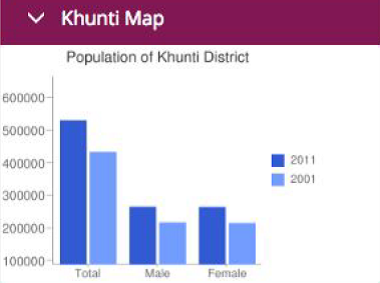
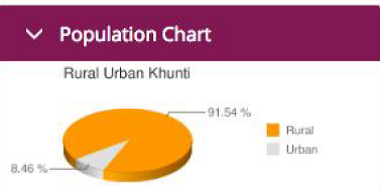
District Density
The initial provisional data released by census India 2011, shows that density of Khunti district for 2011 is 210 people per sq. km. In 2001, Khunti district density was at 176 people per sq. km. Khunti district administers 2,535 square kilometers of areas.
Literacy Rate
Average literacy rate of Khunti in 2011 were 63.86 compared to 52.92 of 2001. If things are looked out at gender wise, male and female literacy were 74.08 and 53.69 respectively. For 2001 census, same figures stood at 67.40 and 38.40 in Khunti District. Total literate in Khunti District were 284,575 of which male and female were 164,741 and 119,834 respectively. In 2001, Khunti District had 192,025 in its district.
Sex Ratio
With regards to Sex Ratio in Khunti, it stood at 997 per 1000 male compared to 2001 census figure of 992. The average national sex ratio in India is 940 as per latest reports of Census 2011 Directorate. In 2011 census, child sex ratio is 964 girls per 1000 boys compared to figure of 966 girls per 1000 boys of 2001 census data.
Child Population
In census enumeration, data regarding child under 0-6 age were also collected for all districts including Khunti. There were total 86,292 children under age of 0-6 against 71,978 of 2001 census. Of total 86,292 male and female were 43,947 and 42,345 respectively. Child Sex Ratio as per census 2011 was 964 compared to 966 of census 2001. In 2011, Children under 0-6 formed 16.22 percent of Khunti District compared to 16.55 percent of 2001. There was net change of -0.33 percent in this compared to previous census of India.
Houseless Census
In 2011, total 63 families live on footpath or without any roof cover in Khunti district of Jharkhand. Total Population of all who lived without roof at the time of Census 2011 numbers to 258. This approx 0.05% of total population of Khunti district.
Census Data 2011 at a glance
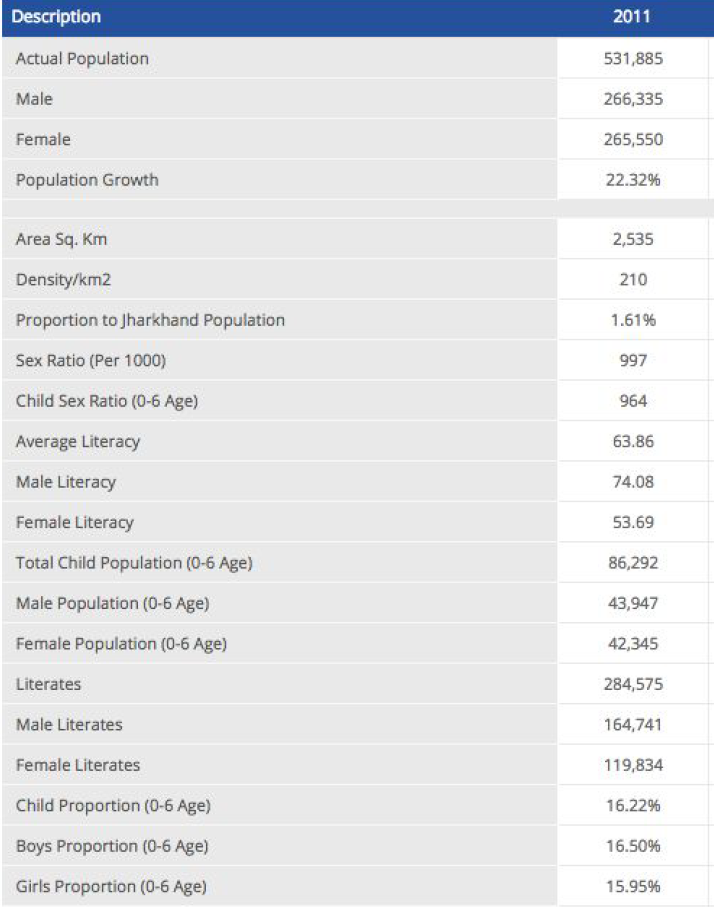
Religion-Wise Data
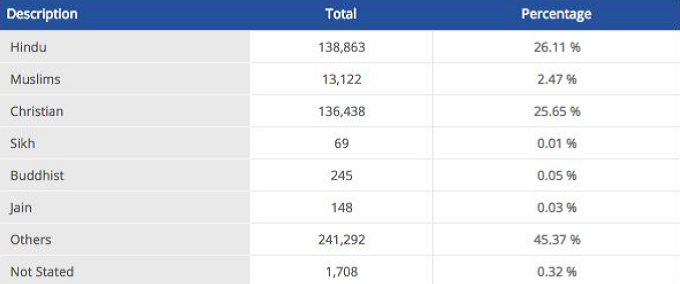
Urban/Rural Data
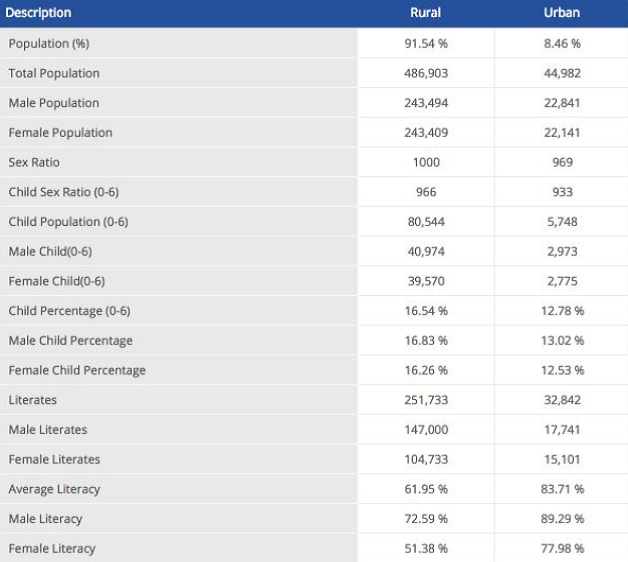
Last Modified : 11/22/2023
Provides information about Surakshit Hum Surakshit...
